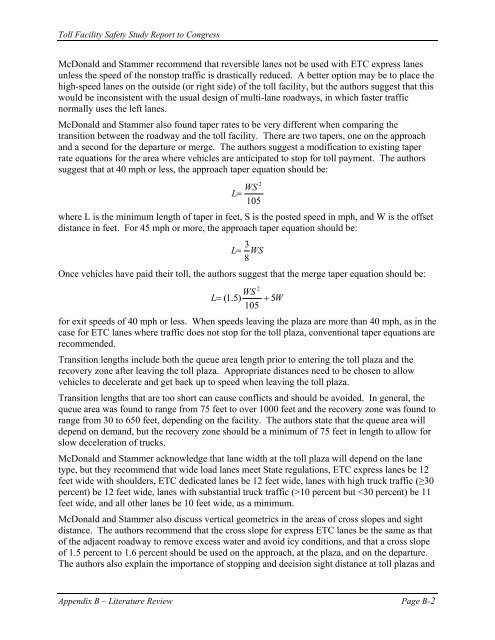Toll Facility Safety Study Report to Congress - About
Toll Facility Safety Study Report to Congress - About
Toll Facility Safety Study Report to Congress - About
You also want an ePaper? Increase the reach of your titles
YUMPU automatically turns print PDFs into web optimized ePapers that Google loves.
<strong>Toll</strong> <strong>Facility</strong> <strong>Safety</strong> <strong>Study</strong> <strong>Report</strong> <strong>to</strong> <strong>Congress</strong><br />
McDonald and Stammer recommend that reversible lanes not be used with ETC express lanes<br />
unless the speed of the nons<strong>to</strong>p traffic is drastically reduced. A better option may be <strong>to</strong> place the<br />
high-speed lanes on the outside (or right side) of the <strong>to</strong>ll facility, but the authors suggest that this<br />
would be inconsistent with the usual design of multi-lane roadways, in which faster traffic<br />
normally uses the left lanes.<br />
McDonald and Stammer also found taper rates <strong>to</strong> be very different when comparing the<br />
transition between the roadway and the <strong>to</strong>ll facility. There are two tapers, one on the approach<br />
and a second for the departure or merge. The authors suggest a modification <strong>to</strong> existing taper<br />
rate equations for the area where vehicles are anticipated <strong>to</strong> s<strong>to</strong>p for <strong>to</strong>ll payment. The authors<br />
suggest that at 40 mph or less, the approach taper equation should be:<br />
2<br />
WS<br />
L<br />
105<br />
where L is the minimum length of taper in feet, S is the posted speed in mph, and W is the offset<br />
distance in feet. For 45 mph or more, the approach taper equation should be:<br />
3<br />
L WS<br />
8<br />
Once vehicles have paid their <strong>to</strong>ll, the authors suggest that the merge taper equation should be:<br />
2<br />
WS<br />
L ( 1.<br />
5)<br />
5W<br />
105<br />
for exit speeds of 40 mph or less. When speeds leaving the plaza are more than 40 mph, as in the<br />
case for ETC lanes where traffic does not s<strong>to</strong>p for the <strong>to</strong>ll plaza, conventional taper equations are<br />
recommended.<br />
Transition lengths include both the queue area length prior <strong>to</strong> entering the <strong>to</strong>ll plaza and the<br />
recovery zone after leaving the <strong>to</strong>ll plaza. Appropriate distances need <strong>to</strong> be chosen <strong>to</strong> allow<br />
vehicles <strong>to</strong> decelerate and get back up <strong>to</strong> speed when leaving the <strong>to</strong>ll plaza.<br />
Transition lengths that are <strong>to</strong>o short can cause conflicts and should be avoided. In general, the<br />
queue area was found <strong>to</strong> range from 75 feet <strong>to</strong> over 1000 feet and the recovery zone was found <strong>to</strong><br />
range from 30 <strong>to</strong> 650 feet, depending on the facility. The authors state that the queue area will<br />
depend on demand, but the recovery zone should be a minimum of 75 feet in length <strong>to</strong> allow for<br />
slow deceleration of trucks.<br />
McDonald and Stammer acknowledge that lane width at the <strong>to</strong>ll plaza will depend on the lane<br />
type, but they recommend that wide load lanes meet State regulations, ETC express lanes be 12<br />
feet wide with shoulders, ETC dedicated lanes be 12 feet wide, lanes with high truck traffic (≥30<br />
percent) be 12 feet wide, lanes with substantial truck traffic (>10 percent but

















